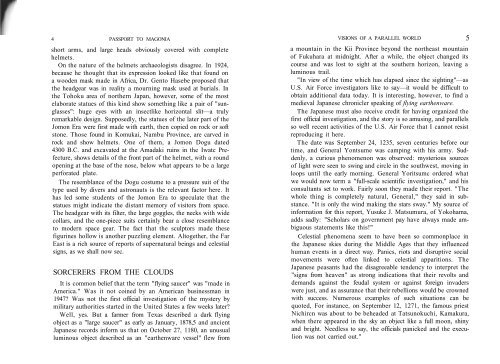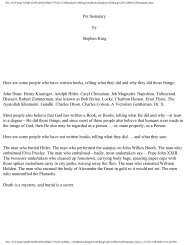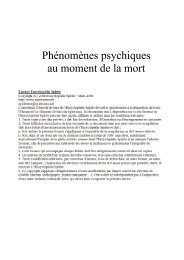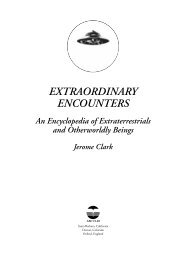You also want an ePaper? Increase the reach of your titles
YUMPU automatically turns print PDFs into web optimized ePapers that Google loves.
4 PASSPORT TO MAGONIA<br />
short arms, and large heads obviously covered with complete<br />
helmets.<br />
On the nature of the helmets archaeologists disagree. In 1924,<br />
because he thought that its expression looked like that found on<br />
a wooden mask made in Africa, Dr. Gento Hasebe proposed that<br />
the headgear was in reality a mourning mask used at burials. In<br />
the Tohoku area of northern Japan, however, some of the most<br />
elaborate statues of this kind show something like a pair of "sunglasses":<br />
huge eyes with an insectlike horizontal slit—a truly<br />
remarkable design. Supposedly, the statues of the later part of the<br />
Jomon Era were first made with earth, then copied on rock or soft<br />
stone. Those found in Komukai, Nambu Province, are carved in<br />
rock and show helmets. One of them, a Jomon Dogu dated<br />
4300 B.C. and excavated at the Amadaki ruins in the Iwatc Prefecture,<br />
shows details of the front part of the helmet, with a round<br />
opening at the base of the nose, below what appears to be a large<br />
perforated plate.<br />
The resemblance of the Dogu costume to a pressure suit of the<br />
type used by divers and astronauts is the relevant factor here. It<br />
has led some students of the Jomon Era to speculate that the<br />
statues might indicate the distant memory of visitors from space.<br />
The headgear with its filter, the large goggles, the necks with wide<br />
collars, and the one-piece suits certainly bear a close resemblance<br />
to modern space gear. The fact that the sculptors made these<br />
figurines hollow is another puzzling element. Altogether, the Far<br />
East is a rich source of reports of supernatural beings and celestial<br />
signs, as we shall now sec.<br />
SORCERERS FROM THE CLOUDS<br />
It is common belief that the term "flying saucer" was "made in<br />
America." Was it not coined by an American businessman in<br />
1947? Was not the first official investigation of the mystery by<br />
military authorities started in the United States a few weeks later?<br />
Well, yes. But a farmer from Texas described a dark flying<br />
object as a "large saucer" as early as January, 1878,5 and ancient<br />
Japanese records inform us that on October 27, 1180, an <strong>unusual</strong><br />
luminous object described as an "earthenware vessel" flew from<br />
VISIONS OF A PARALLEL WORLD 5<br />
a mountain in the Kii Province beyond the northeast mountain<br />
of Fukuhara at midnight. After a while, the object changed its<br />
course and was lost to sight at the southern horizon, leaving a<br />
luminous trail.<br />
"In view of the time which has elapsed since the sighting"—as<br />
U.S. Air Force investigators like to say—it would be difficult to<br />
obtain additional data today. It is interesting, however, to find a<br />
medieval Japanese chronicler speaking of flying earthenware.<br />
The Japanese must also receive credit for having organized the<br />
first official investigation, and the story is so amusing, and parallels<br />
so well recent activities of the U.S. Air Force that I cannot resist<br />
reproducing it here.<br />
The date was September 24, 1235, seven centuries before our<br />
time, and General Yontsume was camping with his army. Suddenly,<br />
a curious phenomenon was observed: mysterious sources<br />
of light were seen to swing and circle in the southwest, moving in<br />
loops until the early morning. General Yoritsumc ordered what<br />
we would now term a "full-scale scientific investigation," and his<br />
consultants set to work. Fairly soon they made their report. "The<br />
whole thing is completely natural, General," they said in substance.<br />
"It is only the wind making the stars sway." My source of<br />
information for this report, Yusuke J. Matsumura, of Yokohama,<br />
adds sadly: "Scholars on government pay have always made ambiguous<br />
statements like this!"<br />
Celestial phenomena seem to have been so commonplace in<br />
the Japanese skies during the Middle Ages that they influenced<br />
human events in a direct way. Panics, riots and disruptive social<br />
movements were often linked to celestial apparitions. The<br />
Japanese peasants had the disagreeable tendency to interpret the<br />
"signs from heaven" as strong indications that their revolts and<br />
demands against the feudal system or against foreign invaders<br />
were just, and as assurance that their rebellions would be crowned<br />
with success. Numerous examples of such situations can be<br />
quoted, For instance, on September 12, 1271, the famous priest<br />
Nichircn was about to be beheaded at Tatsunokuchi, Kamakura,<br />
when there appeared in the sky an object like a full moon, shiny<br />
and bright. Needless to say, the officials panicked and the execulion<br />
was not carried out."





